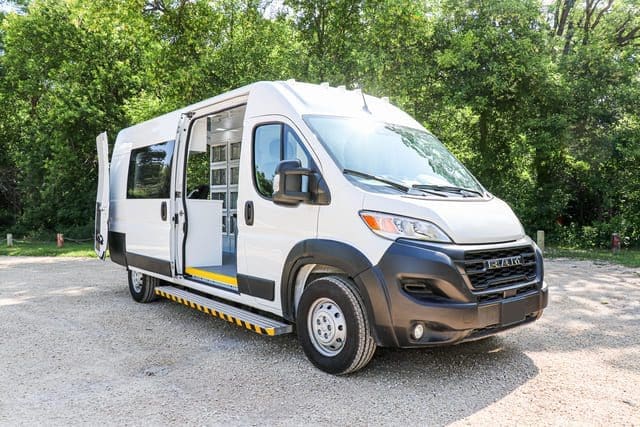According to a recent survey, around 70 million Americans admitted to using illicit drugs. This alarming statistic highlights just how many people may potentially end up struggling with addiction. If you’re an organization in California trying to help these individuals, you might wonder how to reach them and make a real impact.
One effective way is to start a Mobile Narcotic Treatment Program (MNTP) clinic in California. But getting started can be confusing. Some questions you might have are:
- How do you find funding?
- What’s the application process?
- What’s the right mobile health vehicle for this?
These are big questions, and it’s okay to feel a bit overwhelmed.
At AVAN Mobility, we’ve been manufacturing mobile health vehicles, helping organizations like yours provide various healthcare services across the U.S. for over 10 years. Our mission is to reduce barriers and save lives. We understand the challenges you face in starting a MNTP clinic, and we’re here to guide you in the right direction.
In this article, you’ll learn what’s involved in launching an MNTP clinic in California, covering everything from the general requirements to the application process and finding the right funding to get your program off the ground. By the time you’re finished reading, you’ll have a better idea of how to navigate the MNTP clinic application process and get your program off the ground with confidence.
Is there funding for MNTP clinics in California?
First things first, when you’re planning to start an MNTP clinic, securing funding is one of the most important steps. Having financial support will make the next steps much easier. The Department of Health Care Services (DHCS) in California offers two types of funding: Track One and Track Two.
Track One: Medication Unit (MU):
For Track One, you can apply for up to $400,000 per medication unit. This money is for getting new medication units up and running—it can’t be used for ongoing costs or existing work. If your organization wants to set up more than one medication unit at a narcotic treatment program site, you’ll need to submit a separate application for each one.
Track Two: Mobile Narcotic Treatment Program:
Track Two offers up to $1,000,000 for starting a new mobile narcotic treatment program. Like Track One, this funding is only for startup costs and not for ongoing expenses. If you’re looking to set up more than one MNTP at a site, you’ll also need a separate application for each one.
What are the funding eligibility requirements?
To be eligible for this funding, your organization must meet these basic criteria:
- Be a nonprofit organization.
- Have a valid DHCS license for the primary NTP.
- Hold a valid DEA Registration.
- Have SAMHSA accreditation.
- Be enrolled in Drug Medi-Cal (DMC).
Location requirement:
Your organization must be based in California to apply for this funding.
What are the requirements to start a MNTP clinic in California?
Apart from securing funding, as we discussed in the section above, there are several steps you must follow. Let’s take a closer look at what’s involved in that.
Starting a MNTP clinic in California involves meeting a few key requirements. Here’s a simple breakdown of what you need to know:
General Requirements
A mobile NTP, according to California law, must:
1. Be linked to one NTP: Your mobile clinic can only operate under the license of one specific NTP. It can’t be linked to multiple NTPs at the same time.
2. Follow all regulations: The clinic must follow all rules and laws at every level—state, federal, tribal, and local. This includes all the specific requirements outlined in the Behavioral Health Information Notice (BHIN).
3. Get necessary approvals: Before you can start operating your mobile NTP, you need to get approvals from three key organizations:
- California Department of Health Care Services
- Drug Enforcement Administration (DEA)
- Substance Abuse and Mental Health Services Administration (SAMHSA)
Once you’re aware of these requirements, you can then move on to the application process.
What’s the application process for a MNTP clinic?
Starting a MNTP clinic in California involves a detailed application process. Here’s how to get started:
First, you’ll need to complete the MNTP initial application form DHCS 1830. This form is submitted to the California Department of Health Care Services to get preliminary approval. There are a number of things that you’ll highlight in your application:
1. Describe the service area:
You need to explain the areas your clinic will serve, including specific addresses or a description of the locations where you’ll be dispensing medication.
2. Detail the population served:
Provide a written statement that describes the population in the areas you plan to serve.
3. Provide staff information:
Include resumes for every staff member and a list of names and job titles for those who will have access to the safe storing medication.
4. Explain medication transfer:
Describe how medications will be transferred from the main NTP to your mobile NTP.
5. Outline the operation schedule:
Include a schedule with the days and hours your mobile clinic will dispense medications.
6. Submit a clinic layout:
Provide a diagram showing your mobile clinic’s layout, including the safe’s dimensions for storing controlled substances and the patient flow.
Curious to learn what type of vehicle works best for starting an MNTP clinic? Click the button below to talk to an expert.
Continue your application process
7. Estimate patient numbers:
Give an estimate of the number of patients you plan to serve and describe how they will participate in regular treatment.
8. Describe medication tracking:
Explain how you’ll track and account for all controlled substances on the mobile clinic.
9. Provide vehicle documentation:
Submit a copy of your mobile clinic’s vehicle registration and proof of auto insurance.
10. Outline security measures:
Describe the safe’s alarm system and its connection to a central protection company or local police.
11. Map out standard routes:
Include a written statement and map of your clinic’s standard routes to and from dispensing locations.
12. Prepare emergency plans:
Outline the procedures for emergencies, including how you’ll secure controlled substances and notify patients if services are delayed or canceled.
This process might seem complicated, but it’s essential to ensure your MNTP clinic operates smoothly and safely.
What happens after the MNTP application is submitted?
Once you submit your MNTP application, the Department will review it within 60 days. Here’s what you can expect:
Review process: The Department will check if your application is complete. If it’s missing information, they’ll let you know what’s needed. You’ll have 60 days to provide the missing details.
Approval or denial: If your application is complete, the Department will either grant preliminary approval or deny it within 60 days. If denied, they’ll explain why and guide you on how to reapply.
If approved, your MNTP clinic can move forward with the next steps below toward operation.
Federal approval
Once you have preliminary approval from the Department, you need to get approval from the DEA and SAMHSA. Notify your local DEA office about your intent to operate a mobile NTP and secure all necessary federal approvals.
On-site inspection
Before final approval, the Department will conduct an on-site inspection of your mobile NTP and its parking location to ensure you meet all State and federal requirements.
Final approval
After receiving DEA and SAMHSA approval, your organization must send these approvals to the Department within 30 days. The Department will then give you a final approval notice, allowing your mobile NTP to begin operations. You have six months from this approval to make your mobile NTP operational. If there’s a delay, you must inform the Department with a detailed explanation.
Take a closer look at the MNTP application process to learn more.
What vehicles work best for MNTP clinics?

When choosing a vehicle for an MNTP clinic, prioritize privacy and functionality. Look for a vehicle with:
- Mobile office space for administrative tasks.
- Cabinetry for storing medical equipment, supplies, and records.
- A sink and countertop space for medical procedures.
- An aluminum build for a sterile and easy-to-clean environment.
- Bright LED lighting to ensure a well-lit workspace.
- A reliable power supply to keep all equipment running smoothly.
These features create a secure and efficient mobile clinic that meets the needs of both healthcare providers and patients. The Mobile Mitigation Van that we manufacture at AVAN Mobility has all of these features and more.
Ready to launch your MNTP clinic in California?
You came to this article looking for guidance on how to start a MNTP clinic in California. Now, you’ve learned about the steps involved, the funding options available, and the specific requirements you need to meet.
At AVAN Mobility, we know that starting a program to reach and support those struggling with addiction can be a bit tricky. Our commitment to manufacturing solutions to reduce barriers and save lives drives everything we do. If you’re still wondering about anything or need a bit more guidance on setting up your MNTP clinic, simply click the button below to speak with a mobility expert.
If you’re not ready to talk to someone yet, that’s okay. We have a few other resources you can check out to learn more. Start by checking out the video below for a closer look at how much you can expect to pay for a MNTP clinic.





